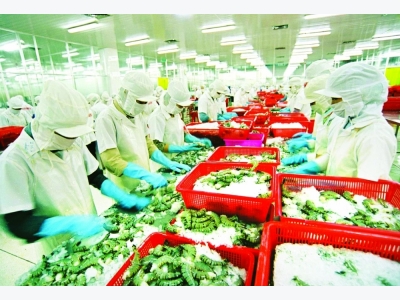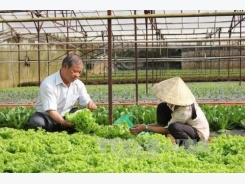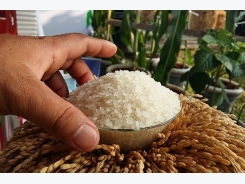The highs and lows of 2017 farming

Agro-forestry-fishery production has recovered and grown to become a highlight of the agricultural sector in 2017, despite difficulties and challenges associated with natural disasters and tough competition.
Fisheries will continue to be a major Vietnamese export source
Rice production
In the first 10 months of 2017, natural disasters caused damages worth an estimated VND36.51 trillion, or more than US$1.6 billion. The damage affected over 300,000 hectares of rice, vegetables and other crops. Immediately after the storms and floods stopped, the Ministry of Agriculture and Rural Development worked with other ministries to assist farmers in restoring production. As a result, almost 7.7 million hectares of rice were planted nationwide in 2017. Many areas in the central coastal region and the Central Highlands, which experienced a poor crop in 2016, have had a bumper crop in 2017, with their rice production and output increasing 9.7 percent and 10.6 percent over the same period of 2016, respectively.
According to the Department of Crop Production, since early 2017, more than 7.7 million hectares of rice have been grown throughout the country (down 26,100ha compared to 2016), with an estimated yield of 5.55 tonnes per hectare (down 30kg) and estimated output of 42.84 million tonnes (down 356,000 tonnes compared to 2016). The cultivation sector’s production value has increase two percent over 2016, with cultivated areas of less efficient crops – rice, maize and short-term cash crops - decreasing by 26,100ha, 52,000ha and 3,000ha, respectively. Cultivated areas of efficient crops – fruit trees and vegetables – increased 50,000ha and 22,000ha.
The production structure has been adjusted in accordance with market specifications to bring into full play advantages of each locality and the whole country. A number of key products have carved out niches in foreign markets.
Fruit, vegetables
The past year has been successful for the fruit and vegetable sector, with discerning markets, including the US, EU and Australia, licensing Vietnamese fruit imports – some of them for the first time. In 2017, Vietnam exported fruits and vegetables worth more than US$3.51 billion, up 43.02 percent from 2016.
The government is increasingly interested in the fruit and vegetable industry. On December 18, 2017, Prime Minister Nguyen Xuan Phuc chaired a forum themed “Market development for the fruit and vegetable sector and solutions for agricultural and rural logistics development” sponsored by the Dong Thap Province People’s Committee in coordination with the Vietnam Organic Agri-Economy Institute (VOAEI).
The Prime Minister said at the forum that the country’s fruit and vegetable exports were growing rapidly and had surpassed both rice and oil exports in value. “We shouldn’t say much about achievements, but talk about solutions to continue strongly and rapidly developing the industry in the coming time. While Vietnam is one of the world’s top 50 fruit and vegetable exporters, the country’s fruit and vegetable exports have accounted for only one percent of the world market’s trade in these products. This shows that our development is not commensurate with the potential and there is room for us to grow. It is successful that this forum attracted leading importers from major fruit and vegetable buying countries, including the US, Japan, China, and the Republic of Korea (RoK),” the Prime Minister said.
According to the Prime Minister, Vietnam’s fruit and vegetable industry is weak in processing, post-harvest preservation, and high and increased logistics costs, which have increased Vietnamese farm product cost and decreased their competitiveness. “Localities need to create opportunities for enterprises, especially private businesses, to join and develop fruit and vegetable production and export. Vietnam targets to reach US$5 billion worth of fruit and vegetable exports by 2020, and product quality improvement, good price and ensuring fair profit sharing among value chain participants are integral to reach the target,” Prime Minister Nguyen Xuan Phuc said.
Vietnam’s fruit and vegetable exports are expected to reach US$7 billion by 2030. Prof. Dr. Nguyen Hong Son, Director of the Department of Crop Production, said real changes in investment, production restructuring, advanced science and technology application, infrastructure improvement, and research and creation of salinity-resistant fruit varieties are important for Vietnam to reach that export value.
Shrimp power
Early this year, the Prime Minister said determination and comprehensive solutions are needed to bring into play the special advantages of the shrimp industry. The shrimp industry should provide a good example of modern, high added value agriculture development and become a global highlight in terms of the 4th industrial revolution’s achievements. Vietnam targets shrimp export value of US$10 billion by 2025. The Vietnam Association of Seafood Exporters and Producers (VASEP) has predicted that seafood exports would reach US$8.2 billion in 2017 (compared with US$7.1 billion in 2016).
This year, the agro-forestry-fishery sector is expected to reach gross domestic product (GDP) and production value growths of 3 and 3.1 percent over 2016, an export value of estimated US$35 billion (up US$2.82 billion or 8.7 percent from 2016), and a forest coverage rate of 41.45 percent.
Minister of Agriculture and Rural Development, Nguyen Xuan Cuong, said the agriculture and rural development sector will have to work hard to reach efficient and sustainable development targets pertaining to new rural area development aimed at improving farm produce quality, protecting the environment and enriching farmers.
Vietnam has reached annual fruit-vegetable and shrimp export values of US$3 billion and US$3.2 billion. It targets increasing the revenues in these areas to US$9-10 billion and US$10 billion by 2022 and 2025, respectively.
Có thể bạn quan tâm
Phần mềm

Phối trộn thức ăn chăn nuôi

Pha dung dịch thủy canh

Định mức cho tôm ăn

Phối trộn phân bón NPK

Xác định tỷ lệ tôm sống

Chuyển đổi đơn vị phân bón

Xác định công suất sục khí

Chuyển đổi đơn vị tôm

Tính diện tích nhà kính

Tính thể tích ao hồ



 There is investment wave in agriculture: Institute Head
There is investment wave in agriculture: Institute Head  Root discovery may lead to crops that need…
Root discovery may lead to crops that need…